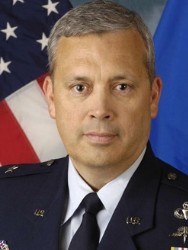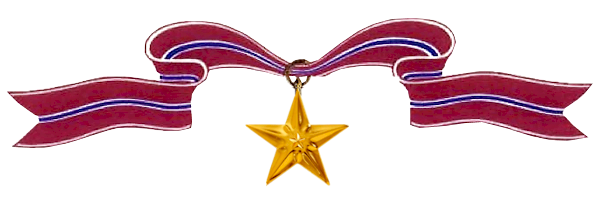Michael Longoria graduated from the U.S. Air Force Academy at Colorado Springs, Colorado, Class of 1979. He retired in 2009 as a U.S. Air Force Brigadier General.

–
Awards Received
-

Bronze Star Medal
-

Bronze Star Medal
-

Bronze Star Medal
-

Bronze Star Medal
-

Bronze Star Medal
-
Bronze Star Medal
Service:
United States Air ForceRank:
ColonelAction Date:
September 20 – December 19, 2001
The President of the United States of America, authorized by Executive Order 11046, 24 August 1962, takes pleasure in presenting a Bronze Oak Leaf Cluster in lieu of a Second Award of the Bronze Star Medal to Colonel Michael A. Longoria, United States Air Force, for meritorious achievement as Commander, 18th Air Expeditionary Group, while engaged in ground operations against an enemy of the United States at Karshi-Kanabad, Uzbekistan, Bagram and Kandahar Airfields, Afghanistan; Camp Doha, Kuwait and other classified locations, from 20 September 2001 to 19 December 2001. During this period, Colonel Longoria was one of the first officers to arrive in theater supporting Operation ENDURING FREEDOM. During the first 21 days, he flew to 13 different countries and directed the development of the single air-ground control system, designed to provide close air support to forces within Afghanistan. He provided unprecedented support to the 5th Special Forces Group, Marine Task Force 58, the 75th Ranger Regiment, Naval Special Warfare elements, special government agencies, and national mission forces in 11 different countries while directly supporting the initial combat parachute and heliborne infiltrations into the northern and southern regions of Afghanistan. He also orchestrated the first comprehensive forward air control plan and provided specialized air/ground integration for fighter, bomber, reconnaissance and airlift support to special operations forces achieving unprecedented success in the ground-directed interdiction campaign. During this period, forward air controllers directed over 415 air bombardment missions destroying over 3,500 enemy personnel, 150 tanks and artillery, and over 180 fortified positions culminating in the withdrawal of the Taliban and al-Quada forces into regions near the Pakistan border. Colonel Longoria additionally manned all United States Air Force liaison positions at every command and control node to include three joint special operations task forces, the special operations elements within the Combined Air Operations Center in Saudi Arabia and the land and Maritime Component Commands in Kuwait and Bahrain. The exemplary leadership, personal endeavor, and devotion to duty displayed by Colonel Longoria in this responsible position reflect great credit upon himself and the United States Air Force.
-
Bronze Star Medal
Service:
United States Air ForceRank:
Brigadier GeneralAction Date:
January 16 – July 17, 2006
The President of the United States of America, authorized by Executive Order 11046, 24 August 1962, takes pleasure in presenting a Fourth Bronze Oak Leaf Cluster in lieu of a Fifth Award of the Bronze Star Medal to Brigadier General Michael A. Longoria, United States Air Force, for exceptionally meritorious conduct in the performance of outstanding service to the United States as Commanding General, Joint Interagency Task Force-High Value Individuals, Multi-National Force-Iraq, Baghdad, Iraq, from 16 January 2006 to 17 July 2006 during Operation IRAQI FREEDOM. Brigadier General Longoria directed the effort that successfully located, tracked, and targeted the enablers, financiers, advisors, and leaders of the insurgency who perpetuated terrorism. His focus on finding and defeating high value individuals directly improved the security environment and helped restore the rule of law in Iraq. Brigadier General Longoria’s actions are in keeping with the highest traditions of the military service and reflect distinct credit upon himself, the Multi-National Force-Iraq, and the United States Air Force.
-
Bronze Star Medal
Service:
United States Air ForceRank:
ColonelAction Date:
December 20, 2001 – January 10, 2002
The President of the United States of America, authorized by Executive Order 11046, 24 August 1962, takes pleasure in presenting a Second Bronze Oak Leaf Cluster in lieu of a Third Award of the Bronze Star Medal with Combat “V” to Colonel Michael A. Longoria, United States Air Force, for heroism as Mission Commander for a prisoner movement team, while engaged in ground operations against an enemy of the United States at Bagram Airfield, Afghanistan, and other classified locations within Pakistan, from 20 December 2001 to 10 January 2002. During this period, Colonel Longoria displayed remarkable courage in the face of constant sniper fire, hostile local populations and escaped al-Qaeda fighters near the vicinity of Parachinar, 45 miles southwest of Peshawar. He directed joint forces in the assessment and selection of an airfield and then accompanied Pakistani officials to various prisoner locations. During a prisoner reconnaissance patrol, Colonel Longoria and a Pakistani escort team came under intense fire from a group of escaped al-Qaeda and Taliban forces halting the Pakistani ground convoy in an open position in the Nararai Village Valley. Colonel Longoria helped Pakistani soldiers return fire killing at least two enemy snipers and secured four escaping prisoners with flex cuffs to an overturned bus while awaiting assistance from other Pakistani officials. Exposed to constant enemy sniper fire, he continued to assist in moving wounded government and prisoner casualties from the hostile area. In subsequent missions, he helped secure all 48 escaped prisoners to a new location and affected the transfer of the first 25 most hostile prisoners recaptured following the loss of over 17 Pakistani government officials and prisoners in the bloodiest escape and firefight in Pakistan during Operation ENDURING FREEDOM. By his heroic actions and unselfish dedication to duty, Colonel Longoria has reflected great credit upon himself and the United States Air Force.
-
Bronze Star Medal
Service:
United States Air ForceRank:
ColonelAction Date:
January 31 – May 5, 2003
The President of the United States of America, authorized by Executive Order 11046, 24 August 1962, takes pleasure in presenting a Third Bronze Oak Leaf Cluster in lieu of a Fourth Award of the Bronze Star Medal to Colonel Michael A. Longoria, United States Air Force, for meritorious achievement as Commander, 484th Air Expeditionary Wing while engaged in ground operations against an opposing armed force at Prince Sultan Air Base, Kingdom of Saudi Arabia from 31 January 2003 to 5 May 2003. During this period, Colonel Longoria commanded the first air expeditionary wing consisting of over 7,500 air and ground forces in support of Operation IRAQI FREEDOM. As one of the largest wings in United States Central Command Air Forces, it included three combat operations groups, three expeditionary support groups, and a contingency response group, supporting over 16,000 people. He commanded two air bases in Saudi Arabia and a classified location as well as two expeditionary airfield locations within Iraq. His forces were positioned with every United States Army ground maneuver element engaged in combat operations to include V Corps, 3d Infantry, 4th Infantry, 82d Airborne, 101st Air Assault, and 1st Armored Divisions, the 5th and 10th Special Forces Groups, the 75th Ranger Regiment and the 2d and 3d Cavalry Regiments. Colonel Longoria directed over 2,500 close air support missions responsible for destroying over 450 tanks, 225 artillery pieces, 75 military facilities and over 5,200 enemy soldiers. This close air support campaign is unprecedented in the history of the United States Air Force. The exemplary leadership, personal endeavor, and devotion to duty displayed by Colonel Longoria in this responsible position reflect great credit upon himself and the United States Air Force.
-
Bronze Star Medal

The President of the United States of America, authorized by Executive Order 11046, 24 August 1962, takes pleasure in presenting the Bronze Star Medal to Major Michael A. Longoria, United States Air Force, for meritorious achievement as a Special Operations Combat Controller while engaged in ground operations against an opposing armed force at Rio Hato Airfield, Republic of Panama, from 19 December 1989 to 21 December 1989. On 20 December 1989, Major Longoria performed a night combat parachute jump from five hundred feet in order to assist the ground force commander in coordinating the actions required to secure the airfield. Major Longoria maintained direct liaison between Rangers and Special Tactics personnel who were establishing the runway and providing Air Traffic Control Services. He was also responsible for deconflicting air and ground maneuvers in the combat assault area. Furthermore, he directed medical evacuation activities and coordinated close air support requirements. He put forth the maximum professional effort while exposed to enemy fire. The exemplary leadership, personal endeavor, and devotion to duty displayed by Major Longoria in this responsible position reflect great credit upon himself and the United States Air Force.

